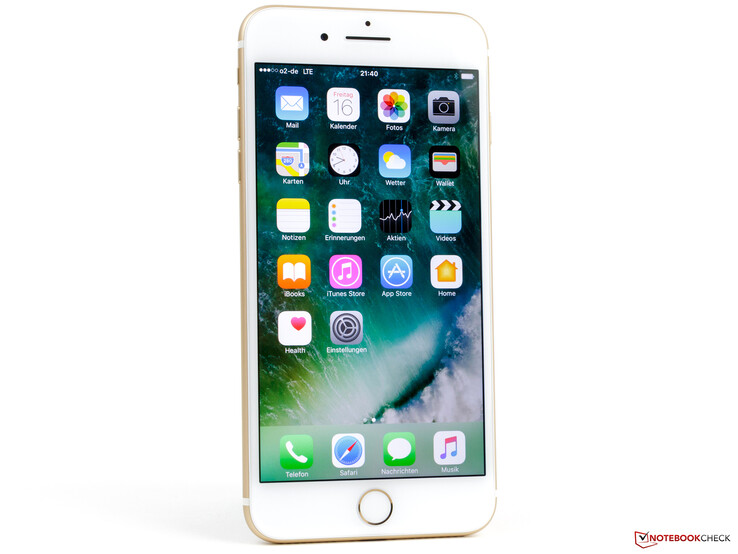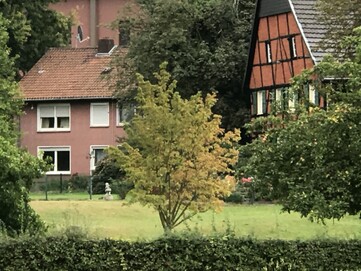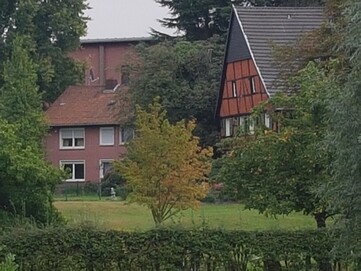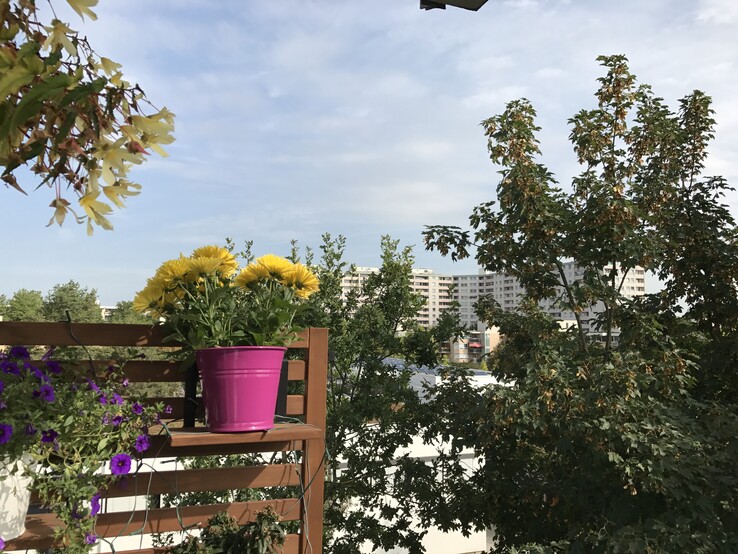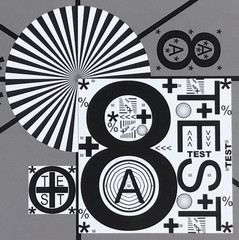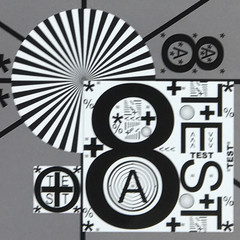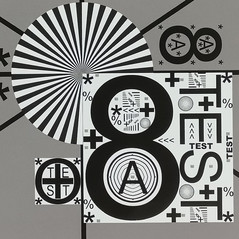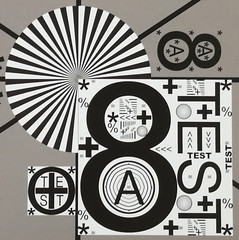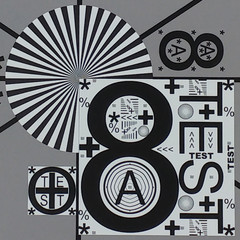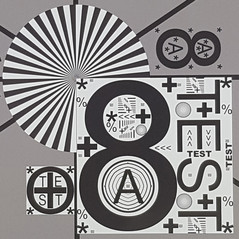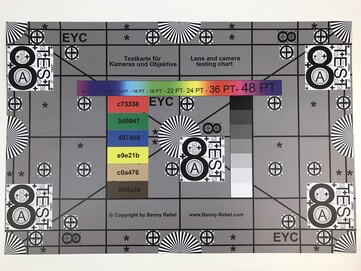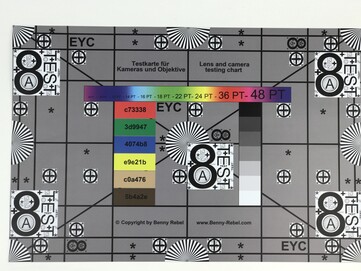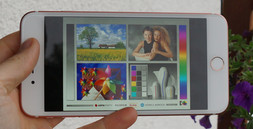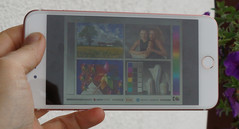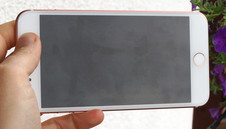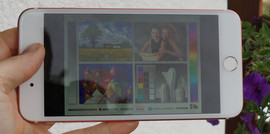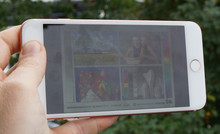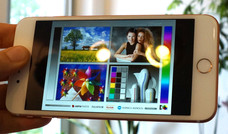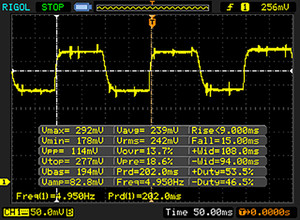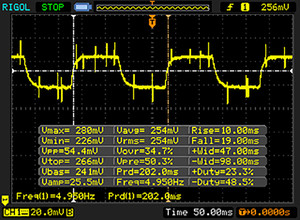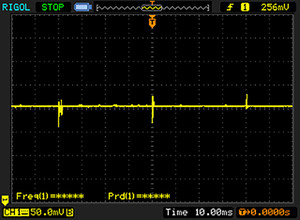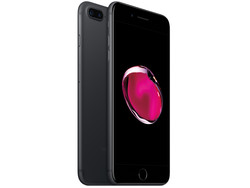Apple iPhone 7 Plus 智能手机简短评测
» Notebookcheck多媒体笔记本电脑Top 10排名
» Notebookcheck游戏笔记本电脑Top 10排名
» Notebookcheck低价办公/商务笔记本电脑Top 10排名
» Notebookcheck高端办公/商务笔记本电脑Top 10排名
» Notebookcheck工作站笔记本电脑Top 10排名
» Notebookcheck亚笔记本电脑Top 10排名
» Notebookcheck超级本产品Top 10排名
» Notebookcheck变形本产品Top 10排名
» Notebookcheck平板电脑Top 10排名
» Notebookcheck智能手机Top 10排名
» Notebookcheck评测过最出色的笔记本电脑屏幕
» Notebookcheck售价500欧元以下笔记本电脑Top 10排名
» Notebookcheck售价300欧元以下笔记本电脑Top 10排名
Size Comparison
| Networking | |
| iperf Server (receive) TCP 1 m | |
| Lenovo Moto Z | |
| Apple iPhone 7 Plus | |
| Samsung Galaxy S7 Edge | |
| OnePlus 3 | |
| Huawei P9 | |
| iperf Client (transmit) TCP 1 m | |
| Apple iPhone 7 Plus | |
| Lenovo Moto Z | |
| Samsung Galaxy S7 Edge | |
| OnePlus 3 | |
| Huawei P9 | |
| |||||||||||||||||||||||||
Brightness Distribution: 97 %
Center on Battery: 558 cd/m²
Contrast: 1591:1 (Black: 0.35 cd/m²)
ΔE ColorChecker Calman: 1.4 | ∀{0.5-29.43 Ø4.78}
ΔE Greyscale Calman: 1.3 | ∀{0.09-98 Ø5}
99.9% sRGB (Calman 2D)
99.83% sRGB (Argyll 1.6.3 3D)
63.1% AdobeRGB 1998 (Argyll 1.6.3 3D)
69% AdobeRGB 1998 (Argyll 3D)
99.8% sRGB (Argyll 3D)
67.2% Display P3 (Argyll 3D)
Gamma: 2.21
CCT: 6667 K
| Apple iPhone 7 Plus IPS, 1920x1080, 5.5" | Apple iPhone 6S Plus IPS, 1920x1080, 5.5" | Samsung Galaxy S7 Edge Super AMOLED, 2560x1440, 5.5" | Samsung Galaxy Note 7 Dual Edge Super AMOLED, 2560x1440, 5.7" | OnePlus 3 Optic-AMOLED, 1920x1080, 5.5" | Huawei P9 IPS-NEO, JDI, 1920x1080, 5.2" | |
|---|---|---|---|---|---|---|
| Screen | -46% | -3% | -12% | -82% | -61% | |
| Brightness middle (cd/m²) | 557 | 583 5% | 554 -1% | 544 -2% | 419 -25% | 582 4% |
| Brightness (cd/m²) | 553 | 560 1% | 552 0% | 523 -5% | 431 -22% | 563 2% |
| Brightness Distribution (%) | 97 | 91 -6% | 96 -1% | 84 -13% | 84 -13% | 91 -6% |
| Black Level * (cd/m²) | 0.35 | 0.46 -31% | 0.38 -9% | |||
| Contrast (:1) | 1591 | 1267 -20% | 1532 -4% | |||
| Colorchecker dE 2000 * | 1.4 | 3.55 -154% | 1.59 -14% | 1.9 -36% | 4.1 -193% | 4.4 -214% |
| Colorchecker dE 2000 max. * | 3.1 | 2.56 17% | 4.2 -35% | 12 -287% | 7.4 -139% | |
| Greyscale dE 2000 * | 1.3 | 3.88 -198% | 2.01 -55% | 1.8 -38% | 3.3 -154% | 4.8 -269% |
| Gamma | 2.21 100% | 2.2 100% | 2.01 109% | 2.12 104% | 2.1 105% | 2.2 100% |
| CCT | 6667 97% | 7280 89% | 6321 103% | 6449 101% | 6550 99% | 6175 105% |
| Color Space (Percent of AdobeRGB 1998) (%) | 63.1 | 59.05 -6% | 82.12 30% | 83.92 33% | 89.38 42% | 77.78 23% |
| Color Space (Percent of sRGB) (%) | 99.83 | 92.8 -7% | 99.98 0% | 100 0% | 100 0% | 99.44 0% |
* ... smaller is better
Display Response Times
| ↔ Response Time Black to White | ||
|---|---|---|
| 24 ms ... rise ↗ and fall ↘ combined | ↗ 9 ms rise | |
| ↘ 15 ms fall | ||
| The screen shows good response rates in our tests, but may be too slow for competitive gamers. In comparison, all tested devices range from 0.1 (minimum) to 240 (maximum) ms. » 53 % of all devices are better. This means that the measured response time is worse than the average of all tested devices (20.2 ms). | ||
| ↔ Response Time 50% Grey to 80% Grey | ||
| 29 ms ... rise ↗ and fall ↘ combined | ↗ 10 ms rise | |
| ↘ 19 ms fall | ||
| The screen shows relatively slow response rates in our tests and may be too slow for gamers. In comparison, all tested devices range from 0.165 (minimum) to 636 (maximum) ms. » 38 % of all devices are better. This means that the measured response time is similar to the average of all tested devices (31.6 ms). | ||
Screen Flickering / PWM (Pulse-Width Modulation)
| Screen flickering / PWM not detected | |||
In comparison: 53 % of all tested devices do not use PWM to dim the display. If PWM was detected, an average of 8118 (minimum: 5 - maximum: 343500) Hz was measured. | |||
| Geekbench 4.0 | |
| 64 Bit Single-Core Score (sort by value) | |
| Apple iPhone 7 Plus | |
| Apple iPhone 6S Plus | |
| Samsung Galaxy S7 Edge | |
| Samsung Galaxy Note 7 | |
| OnePlus 3 | |
| Huawei P9 | |
| 64 Bit Multi-Core Score (sort by value) | |
| Apple iPhone 7 Plus | |
| Apple iPhone 6S Plus | |
| Samsung Galaxy S7 Edge | |
| Samsung Galaxy Note 7 | |
| OnePlus 3 | |
| Huawei P9 | |
| GFXBench (DX / GLBenchmark) 2.7 | |
| T-Rex Onscreen (sort by value) | |
| Apple iPhone 7 Plus | |
| Apple iPhone 6S Plus | |
| Samsung Galaxy S7 Edge | |
| Samsung Galaxy Note 7 | |
| OnePlus 3 | |
| Huawei P9 | |
| 1920x1080 T-Rex Offscreen (sort by value) | |
| Apple iPhone 7 Plus | |
| Apple iPhone 6S Plus | |
| Samsung Galaxy S7 Edge | |
| Samsung Galaxy Note 7 | |
| OnePlus 3 | |
| Huawei P9 | |
| GFXBench 3.0 | |
| on screen Manhattan Onscreen OGL (sort by value) | |
| Apple iPhone 7 Plus | |
| Apple iPhone 6S Plus | |
| Samsung Galaxy S7 Edge | |
| Samsung Galaxy Note 7 | |
| OnePlus 3 | |
| Huawei P9 | |
| 1920x1080 1080p Manhattan Offscreen (sort by value) | |
| Apple iPhone 7 Plus | |
| Apple iPhone 6S Plus | |
| Samsung Galaxy S7 Edge | |
| Samsung Galaxy Note 7 | |
| OnePlus 3 | |
| Huawei P9 | |
| Basemark ES 3.1 / Metal - offscreen Overall Score (sort by value) | |
| Apple iPhone 7 Plus | |
| Apple iPhone 6S Plus | |
| Samsung Galaxy S7 Edge | |
| Samsung Galaxy Note 7 | |
| OnePlus 3 | |
| Huawei P9 | |
| AnTuTu v6 - Total Score (sort by value) | |
| Apple iPhone 7 Plus | |
| Apple iPhone 6S Plus | |
| Samsung Galaxy S7 Edge | |
| Samsung Galaxy Note 7 | |
| OnePlus 3 | |
| Huawei P9 | |
| WebXPRT 2015 - Overall (sort by value) | |
| Apple iPhone 7 Plus | |
| Apple iPhone 6S Plus | |
| Samsung Galaxy S7 Edge | |
| Samsung Galaxy Note 7 | |
| OnePlus 3 | |
| Huawei P9 | |
| Mozilla Kraken 1.1 - Total (sort by value) | |
| Apple iPhone 7 Plus | |
| Apple iPhone 6S Plus | |
| Samsung Galaxy S7 Edge | |
| Samsung Galaxy Note 7 | |
| OnePlus 3 | |
| Huawei P9 | |
| Octane V2 - Total Score (sort by value) | |
| Apple iPhone 7 Plus | |
| Apple iPhone 6S Plus | |
| Samsung Galaxy S7 Edge | |
| Samsung Galaxy Note 7 | |
| OnePlus 3 | |
| Huawei P9 | |
| JetStream 1.1 - Total Score (sort by value) | |
| Apple iPhone 7 Plus | |
| Apple iPhone 6S Plus | |
| Samsung Galaxy S7 Edge | |
| Samsung Galaxy Note 7 | |
| OnePlus 3 | |
| Huawei P9 | |
* ... smaller is better
| PassMark PerformanceTest Mobile V1 - Disk Tests (sort by value) | |
| Apple iPhone 7 Plus | |
| Apple iPhone 6S Plus | |
| Samsung Galaxy S7 Edge | |
| Samsung Galaxy Note 7 | |
| OnePlus 3 | |
| Huawei P9 | |
| BaseMark OS II - Memory (sort by value) | |
| Apple iPhone 7 Plus | |
| Apple iPhone 6S Plus | |
| Samsung Galaxy S7 Edge | |
| Samsung Galaxy Note 7 | |
| OnePlus 3 | |
| Huawei P9 | |
(±) The maximum temperature on the upper side is 42.6 °C / 109 F, compared to the average of 35.2 °C / 95 F, ranging from 21.9 to 247 °C for the class Smartphone.
(±) The bottom heats up to a maximum of 42.8 °C / 109 F, compared to the average of 34 °C / 93 F
(±) In idle usage, the average temperature for the upper side is 32.3 °C / 90 F, compared to the device average of 32.9 °C / 91 F.
Apple iPhone 7 Plus audio analysis
(±) | speaker loudness is average but good (81.4 dB)
Bass 100 - 315 Hz
(-) | nearly no bass - on average 24.1% lower than median
(±) | linearity of bass is average (7.4% delta to prev. frequency)
Mids 400 - 2000 Hz
(+) | balanced mids - only 4.7% away from median
(±) | linearity of mids is average (7.6% delta to prev. frequency)
Highs 2 - 16 kHz
(+) | balanced highs - only 4.3% away from median
(+) | highs are linear (6.9% delta to prev. frequency)
Overall 100 - 16.000 Hz
(±) | linearity of overall sound is average (22% difference to median)
Compared to same class
» 45% of all tested devices in this class were better, 7% similar, 48% worse
» The best had a delta of 11%, average was 35%, worst was 134%
Compared to all devices tested
» 63% of all tested devices were better, 7% similar, 31% worse
» The best had a delta of 4%, average was 24%, worst was 134%
Samsung Galaxy Note 7 audio analysis
(+) | speakers can play relatively loud (85.7 dB)
Bass 100 - 315 Hz
(-) | nearly no bass - on average 28.6% lower than median
(±) | linearity of bass is average (8.5% delta to prev. frequency)
Mids 400 - 2000 Hz
(+) | balanced mids - only 3.5% away from median
(+) | mids are linear (5.2% delta to prev. frequency)
Highs 2 - 16 kHz
(+) | balanced highs - only 4.9% away from median
(+) | highs are linear (6.1% delta to prev. frequency)
Overall 100 - 16.000 Hz
(±) | linearity of overall sound is average (20.8% difference to median)
Compared to same class
» 37% of all tested devices in this class were better, 8% similar, 54% worse
» The best had a delta of 11%, average was 35%, worst was 134%
Compared to all devices tested
» 55% of all tested devices were better, 8% similar, 37% worse
» The best had a delta of 4%, average was 24%, worst was 134%
Apple iPhone 6S audio analysis
(±) | speaker loudness is average but good (75.5 dB)
Bass 100 - 315 Hz
(±) | reduced bass - on average 12.1% lower than median
(±) | linearity of bass is average (10.9% delta to prev. frequency)
Mids 400 - 2000 Hz
(+) | balanced mids - only 3.2% away from median
(+) | mids are linear (4.8% delta to prev. frequency)
Highs 2 - 16 kHz
(±) | higher highs - on average 7% higher than median
(±) | linearity of highs is average (7.2% delta to prev. frequency)
Overall 100 - 16.000 Hz
(±) | linearity of overall sound is average (19.4% difference to median)
Compared to same class
» 27% of all tested devices in this class were better, 8% similar, 65% worse
» The best had a delta of 11%, average was 35%, worst was 134%
Compared to all devices tested
» 47% of all tested devices were better, 7% similar, 46% worse
» The best had a delta of 4%, average was 24%, worst was 134%
| Off / Standby | |
| Idle | |
| Load |
|
Key:
min: | |
| Apple iPhone 7 Plus 2915 mAh | Apple iPhone 6S Plus 2750 mAh | Samsung Galaxy S7 Edge 3600 mAh | Samsung Galaxy Note 7 3500 mAh | OnePlus 3 3000 mAh | Huawei P9 3000 mAh | |
|---|---|---|---|---|---|---|
| Power Consumption | 20% | 18% | 16% | 11% | 10% | |
| Idle Minimum * (Watt) | 0.77 | 0.5 35% | 0.63 18% | 0.72 6% | 0.57 26% | 0.77 -0% |
| Idle Average * (Watt) | 2.04 | 1.9 7% | 1.1 46% | 1.37 33% | 1.24 39% | 2.36 -16% |
| Idle Maximum * (Watt) | 2.24 | 2.2 2% | 1.56 30% | 1.44 36% | 1.36 39% | 2.37 -6% |
| Load Average * (Watt) | 4.69 | 3.2 32% | 5.95 -27% | 5.56 -19% | 5.92 -26% | 3.09 34% |
| Load Maximum * (Watt) | 8.66 | 6.4 26% | 6.7 23% | 6.78 22% | 10.53 -22% | 5.35 38% |
* ... smaller is better
| Apple iPhone 7 Plus 2915 mAh | Apple iPhone 6S Plus 2750 mAh | Apple iPhone 7 1960 mAh | Samsung Galaxy S7 Edge 3600 mAh | Samsung Galaxy Note 7 3500 mAh | OnePlus 3 3000 mAh | Huawei P9 3000 mAh | |
|---|---|---|---|---|---|---|---|
| Battery runtime | -12% | -18% | 25% | 14% | 10% | -16% | |
| Reader / Idle (h) | 30.6 | 27.6 -10% | 29.5 -4% | 27.7 -9% | 23.8 -22% | 22.3 -27% | 25.2 -18% |
| H.264 (h) | 13.6 | 11.9 -12% | 12 -12% | 15.2 12% | 16 18% | 14.1 4% | 9.5 -30% |
| WiFi v1.3 (h) | 9.8 | 8.6 -12% | 8.6 -12% | 12.2 24% | 10.1 3% | 14 43% | 9.5 -3% |
| Load (h) | 3.8 | 3.3 -13% | 2.1 -45% | 6.5 71% | 6 58% | 4.5 18% | 3.4 -11% |
Pros
Cons
第九代iPhone给我们带来了不错的第一印象,它仍然是最优秀的高端手机之一。不过,需要注意的是iPhone 7 Plus并不是一次革命性更新。传说中明年的iPhone 10周年更新将会带来重大变化。它的外观相比iPhone 6S Plus几乎没有变化。它采用了圆滑边角机身,它采用高品质金属材料,坚固防刮蹭。根据网络上的坠落测试结果显示,它的屏幕相比前几代iPhone坚固性有所进步。它机身的另外一个改变是提供了防水。
可能iPhone 7 Plus最大的新功能是双相机,它也给我们带来了不错的感受:它的前置相机现在也有更高分辨率,可以拍摄全高清视频了。不同的光线情况对它的主相机都不是太大的问题,拍摄照片可以一直保持锐利多彩。不过不得不提到的事,其他高端智能手机的表现甚至更好,如三星 Galaxy S7和Note 7,都在这方面保持着领先。
不过Apple明白如何让它的手机保持独一无二,触控引擎提供了极其真实的反馈,与时尚精致操作系统的高度整合也优于其他生产商简单地添加软件,那些功能经常只是变成了宣传噱头。
Retina屏幕仍然提供了出色的显示效果,尽管相比其他同类产品它的像素数现在已经处于劣势。它的对比度,黑值,可视角度和亮度都可以让人满意。在性能上,目前市场上它只有一个竞争对手:iPhone 7。它的电池续航也十分优秀。
如果吹毛求疵的话,iPhone 7 Plus也不是无懈可击:缺少3.5毫米耳机接口让你不得不在转接头和蓝牙耳机间做出选择。iPhone 7 Plus的音响效果也不是特别突出:新的立体声扬声器缺少低音,通话音质也十分一般,它的机身在负载下还会变得很热,同时GPS敏感度有些过高。它的质保只有12个月,而延长质保的价码也不菲。
Apple带来的技术革新幅度相比iPhone刚推出前几年已经放缓了许多,不过它依然是非常优秀的设备。iPhone 7 Plus是一台十分值得考虑购买的设备,不过Apple应该在音响效果上增加一些注意力。
iPhone 7 Plus可以被视作一个踏板,因为我们预期明年的机型将会带来众多技术革新。它依然提供了竞争对手所没有的大量功能,当然它也绝不便宜。
注:本文是基于完整评测的缩减版本,阅读完整的英文评测,请点击这里。
Apple iPhone 7 Plus
- 09/18/2016 v5.1 (old)
Patrick Afschar Kaboli, Daniel Schmidt




